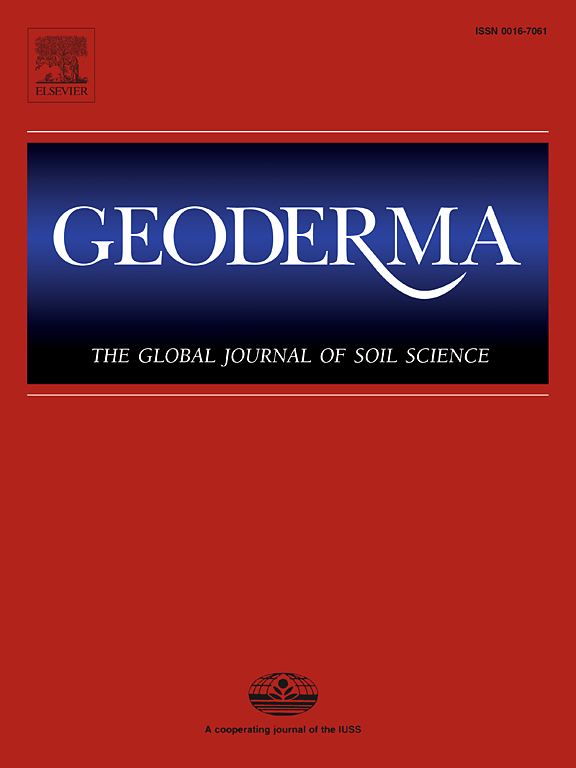LimeSoDa:用于数字土壤制图中机器学习回归量基准测试的数据集集合
IF 5.6
1区 农林科学
Q1 SOIL SCIENCE
引用次数: 0
摘要
数字土壤制图(DSM)依赖于广泛的统计方法,但确定给定背景下的最佳方法仍然具有挑战性和争议性。需要对多个数据集进行基准研究,以揭示常用方法的优势和局限性。现有的DSM研究通常依赖于访问受限的单一数据集,导致结论不完整且可能具有误导性。为了解决这些问题,我们引入了一个开放获取的数据集,称为精确石灰土壤数据集(LimeSoDa)。LimeSoDa由来自不同国家的31个农田和农场规模的数据集组成。每个数据集都有三个目标土壤属性:(1)土壤有机质或土壤有机碳,(2)粘土含量,(3)pH值,以及一系列特征。特征是特定于数据集的,是通过光谱学、近端和远程土壤遥感获得的。所有数据集都对齐为表格格式,并且可以随时用于建模。我们通过比较四种学习算法在所有数据集上的预测性能,演示了使用LimeSoDa进行基准测试。该比较包括多元线性回归(MLR)、支持向量回归(SVR)、分类增强(CatBoost)和随机森林(RF)。结果表明,虽然没有一种算法是普遍优越的,但某些算法在特定情况下表现更好。MLR和SVR在高维光谱数据集上表现更好,可能是由于与主成分的兼容性更好。相比之下,CatBoost和RF在应用于具有中等数量(<20)特征的数据集时表现出相当好的性能。这些基准测试结果表明,统计方法的性能可能高度依赖于上下文。因此,LimeSoDa为改进DSM中统计方法的开发和评价提供了重要的资源。本文章由计算机程序翻译,如有差异,请以英文原文为准。
LimeSoDa: A dataset collection for benchmarking of machine learning regressors in digital soil mapping
Digital soil mapping (DSM) relies on a broad pool of statistical methods, yet determining the optimal method for a given context remains challenging and contentious. Benchmarking studies on multiple datasets are needed to reveal strengths and limitations of commonly used methods. Existing DSM studies usually rely on a single dataset with restricted access, leading to incomplete and potentially misleading conclusions. To address these issues, we introduce an open-access dataset collection called Precision Liming Soil Datasets (LimeSoDa). LimeSoDa consists of 31 field- and farm-scale datasets from various countries. Each dataset has three target soil properties: (1) soil organic matter or soil organic carbon, (2) clay content and (3) pH, alongside a set of features. Features are dataset-specific and were obtained by optical spectroscopy, proximal- and remote soil sensing. All datasets were aligned to a tabular format and are ready-to-use for modeling. We demonstrated the use of LimeSoDa for benchmarking by comparing the predictive performance of four learning algorithms across all datasets. This comparison included multiple linear regression (MLR), support vector regression (SVR), categorical boosting (CatBoost) and random forest (RF). The results showed that although no single algorithm was universally superior, certain algorithms performed better in specific contexts. MLR and SVR performed better on high-dimensional spectral datasets, likely due to better compatibility with principal components. In contrast, CatBoost and RF exhibited considerably better performances when applied to datasets with a moderate number (<20) of features. These benchmarking results illustrate that the performance of statistical methods can be highly context-dependent. LimeSoDa therefore provides an important resource for improving the development and evaluation of statistical methods in DSM.
求助全文
通过发布文献求助,成功后即可免费获取论文全文。
去求助
来源期刊

Geoderma
农林科学-土壤科学
CiteScore
11.80
自引率
6.60%
发文量
597
审稿时长
58 days
期刊介绍:
Geoderma - the global journal of soil science - welcomes authors, readers and soil research from all parts of the world, encourages worldwide soil studies, and embraces all aspects of soil science and its associated pedagogy. The journal particularly welcomes interdisciplinary work focusing on dynamic soil processes and functions across space and time.
 求助内容:
求助内容: 应助结果提醒方式:
应助结果提醒方式:


